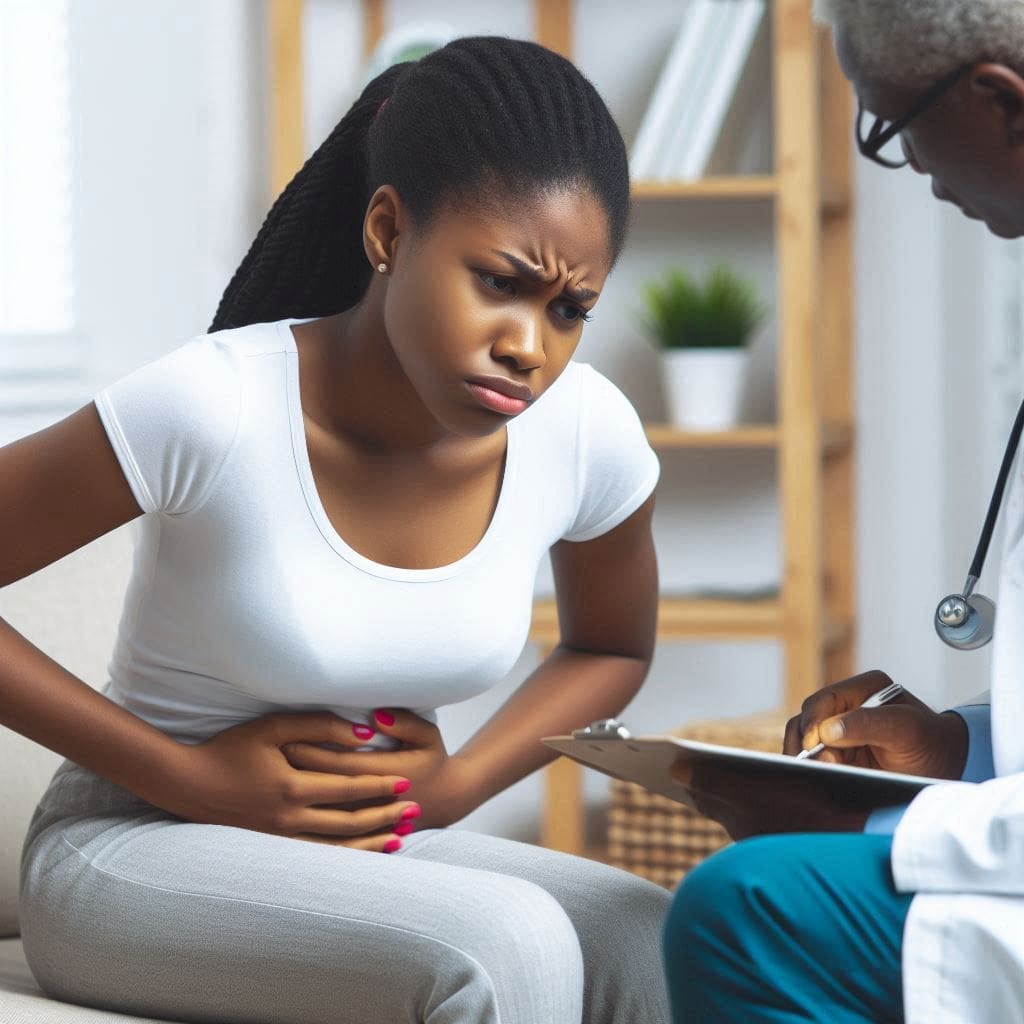
Ovarian cysts are a common health issue affecting many women in Nigeria. Understanding their prevalence, causes, symptoms, and how they impact health and overall wellbeing is essential.
This article will also explain the causes of ovarian cysts, symptoms and how to treat them both medically and traditionally.
What is an Ovarian Cyst?
An ovarian cyst is a fluid-filled sac that forms on or inside an ovary. Many women will have at least one cyst during their lifetime. Ovarian cysts are common and often develop during ovulation. Ovulation is the process where an ovary releases an egg each month.
Most of these cysts are harmless and go away on their own, but some can cause problems.
Prevalence of Ovarian Cysts in Nigeria
Ovarian cysts are quite common among Nigerian women, especially those of childbearing age. Many women will have an ovarian cyst some point in their lives, often without even knowing it, as many cysts are harmless and resolve on their own.
Are Ovarian Cysts Serious?
Typically, no. Most ovarian cysts are harmless and disappear on their own. While some types of cysts have a higher risk of becoming cancerous or causing complications, this is uncommon.
Less than 1% of ovarian cysts turn cancerous. Your healthcare provider can closely monitor any concerning cysts to minimize the risk of complications.
Causes of Ovarian Cysts
These cysts can develop for various reasons, including:
Hormonal Imbalances:
- Changes in hormones can cause the ovaries to develop cysts. This is especially common during the menstrual cycle when hormone levels fluctuate.
Endometriosis:
- Endometriosis occurs when tissue similar to the lining inside the uterus grows outside the uterus. This tissue can attach to the ovaries and form cysts, known as endometriomas.
Pregnancy:
- During early pregnancy, cysts can form to help support the pregnancy until the placenta forms. These cysts usually go away after a few months.
Pelvic Infections:
Additional Causes of Ovarian Cysts
- Polycystic Ovary Syndrome (PCOS):
- PCOS is a condition where many small cysts develop on the ovaries. Women with PCOS often have hormonal imbalances and irregular periods.
- Previous Ovarian Cysts:
- If a woman has had ovarian cysts before, she might be more likely to develop them again in the future.
- Fertility Treatments:
- Some fertility treatments can cause the ovaries to develop multiple cysts as a side effect.
- Hypothyroidism:
- An underactive thyroid can affect hormone levels and lead to the formation of these cysts.
- Cigarette Smoking:
Symptoms of Ovarian Cysts
While many ovarian cysts do not cause symptoms, larger cysts or those that rupture can lead to noticeable symptoms, including:
- Abdominal Pain: Sudden, severe pain in the lower abdomen.
- Bloating: Swelling or a feeling of fullness in the abdomen.
- Menstrual Irregularities: Unusual changes in menstrual cycles.
- Pain During Intercourse: Discomfort or pain during sexual activity.
- Frequent Urination: Needing to urinate more often.
Additional Symptoms of Ovarian Cysts
- Lower Back Pain:
- Pain in the lower back can occur, especially if the cysts grow larger.
- Nausea and Vomiting:
- Feeling sick to your stomach or throwing up can be a sign that a cyst is causing problems.
- Breast Tenderness:
- Your breasts might feel sore or tender due to hormonal changes caused by ovarian cysts.
- Difficulty Emptying Bladder:
- You may find it hard to completely empty your bladder if a cyst is pressing on it.
- Pain During Bowel Movements:
- Some women feel pain during bowel movements if a cyst is pressing on the intestines.
Types of Ovarian Cysts
Ovarian cysts are fluid-filled sacs that can form on or inside the ovaries.
Here are the different types:
Common Types
- Functional Cysts:
- Follicular Cysts: These form when a follicle (a small sac) doesn’t release an egg and continues to grow.
- Corpus Luteum Cysts: These occur after the follicle releases an egg. The sac can seal off and fill with fluid, forming a cyst.
- Dermoid Cysts:
- Endometriomas:
- These cysts form due to endometriosis, where tissue similar to the lining of the uterus grows outside the uterus and attaches to the ovaries.
- Cystadenomas:
- These are fluid-filled cysts that develop on the surface of the ovary. They can be filled with a watery or mucous substance.
- Polycystic Ovary Syndrome (PCOS) Cysts:
Other Types
- Hemorrhagic Cysts:
- These cysts contain blood and can cause pain if they rupture.
- Paraovarian Cysts:
- These cysts form next to the ovary and not on it. They are usually benign and filled with clear fluid.
- Ovarian Cancer Cysts:
- While most ovarian cysts are benign, some can be cancerous. These are more common in older women and require medical evaluation.
Impact on Health and Wellbeing
Ovarian cysts can significantly affect a woman’s health and overall wellbeing. Some potential impacts include:
Pain and Discomfort:
- Ongoing pain from ovarian cysts can make it hard to perform daily activities and reduce your quality of life.
Emotional Stress:
Complications:
- Although rare, ovarian cysts can cause serious complications like:
- Ovarian Torsion: This happens when a cyst causes the ovary to twist, cutting off its blood supply. It leads to severe pain and needs emergency treatment.
- Rupture: A cyst can burst, causing severe pain and internal bleeding. This is also a medical emergency.
Additional Impacts of Ovarian Cysts
Fertility Issues:
- Certain types of ovarian cysts, such as those caused by polycystic ovary syndrome (PCOS), can lead to fertility problems.
Hormonal Imbalances:
- Some cysts can affect hormone levels, leading to symptoms like irregular periods, weight gain, or acne.
Urinary Problems:
- Large cysts can press on the bladder, causing frequent urination or difficulty emptying the bladder completely.
Digestive Issues:
Medical Treatments for Ovarian Cysts

Several medical treatments can help manage ovarian cysts
- Watchful Waiting: Many cysts go away on their own, so doctors may recommend monitoring the cyst with regular ultrasounds.
- Medications: Birth control pills can help prevent new cysts from forming.
- Surgery: In cases where cysts are large, persistent, or causing significant symptoms, surgical removal may be necessary.
Additional Medical Treatments for Ovarian Cysts
- Pain Relievers:
- Over-the-counter pain medications, such as ibuprofen or acetaminophen, can help manage discomfort caused by ovarian cysts.
- Hormonal Therapy:
- Besides birth control pills, other hormonal treatments can help manage cysts. These medications can regulate menstrual cycles and prevent cyst formation.
- Laparoscopy:
- This minimally invasive surgery uses small incisions and a camera to remove cysts. It’s often used for smaller cysts and has a quicker recovery time compared to traditional surgery.
- Laparotomy:
- For larger cysts or when there’s a possibility of cancer, a laparotomy might be performed. This involves a larger incision to remove the cyst and possibly the affected ovary.
- Drainage:
- In some cases, doctors might use a needle to drain fluid from a cyst. This is less common but can be an option for certain types of cysts.
Traditional Treatments for Ovarian Cysts

In addition to medical treatments, some traditional methods may help
- Herbal Remedies: Some people use herbal teas made from plants like chamomile or ginger, believed to reduce pain and inflammation.
- Heat Therapy: Applying a heating pad to the lower abdomen can help relieve pain and discomfort.
- Dietary Changes: Eating a balanced diet rich in fruits, vegetables, and whole grains can support overall health and hormonal balance.
Preventing Ovarian Cysts
While not all ovarian cysts can be prevented, some steps can help reduce the risk:
- Regular Check-Ups: Regular gynecological exams can help detect cysts early.
- Healthy Lifestyle: Maintaining a healthy diet and regular exercise can promote hormonal balance.
- Monitoring Symptoms: Keeping track of menstrual cycles and symptoms can help detect any changes early.
Conclusion
Ovarian cysts are a common issue for many Nigerian women. Understanding their prevalence, causes, symptoms, and treatments can help manage this condition and maintain health and wellbeing.
Both medical and traditional treatments can play a role in managing ovarian cysts, and regular check-ups are crucial for early detection and prevention.



